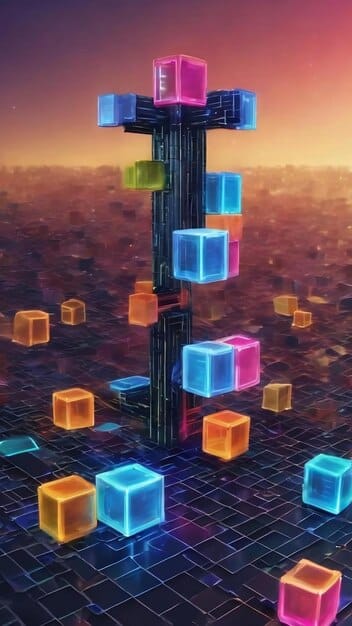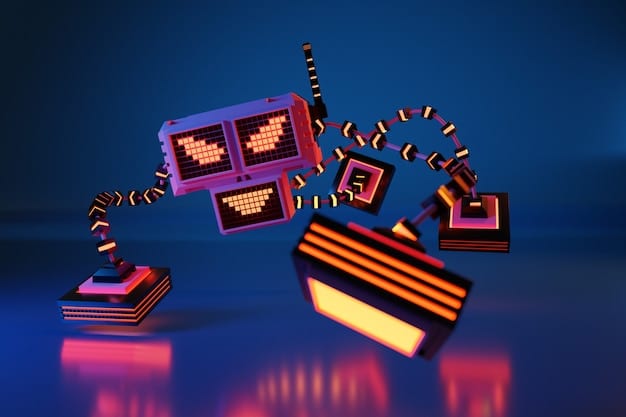Blockchain Games Impact on US Traditional Game Development

The increasing popularity of blockchain games is poised to significantly impact traditional game development in the US, potentially reshaping business models, gameplay mechanics, and player expectations.
The rise of blockchain technology has extended into the gaming industry, sparking a debate on how will the increasing popularity of blockchain games impact traditional game development in the US. This shift could revolutionize how games are developed, distributed, and monetized, creating both opportunities and challenges for established companies.
Understanding the Blockchain Gaming Landscape
Blockchain gaming is a rapidly evolving sector within the broader cryptocurrency and gaming industries. It’s essential to understand its core principles to grasp its potential effects on traditional game development. These games often incorporate aspects such as NFTs (Non-Fungible Tokens) and cryptocurrencies.
What are Blockchain Games?
Blockchain games utilize blockchain technology to enable features not commonly found in traditional games, such as true ownership of in-game assets and decentralized economies.
Key Features of Blockchain Games
These games distinguish themselves through several key characteristics, which significantly differ from the mechanics of traditional games. They introduce unique aspects that attract a different player base.
- Ownership of Assets: Players own their in-game items as NFTs, which can be traded on blockchain marketplaces.
- Play-to-Earn (P2E) Mechanics: Players can earn cryptocurrencies or NFTs by playing the game, creating economic incentives.
- Decentralized Governance: Some games allow players to participate in the decision-making process through DAOs (Decentralized Autonomous Organizations).
- Transparency and Security: Blockchain ensures transparency in game mechanics and security of assets.

Through these features, blockchain games offer a different form of engagement. They shift the players’ roles from mere consumers to active participants who can influence the world around them and even profit from their involvement.
Potential Benefits for Traditional Game Developers
The integration of blockchain technology offers several potential advantages for traditional game developers in the US. By adopting these technologies, they can innovate their business models and player engagement strategies. Exploring these benefits is crucial for staying competitive.
New Revenue Streams
NFT sales and in-game cryptocurrency transactions can open up new revenue streams beyond the traditional game sales and microtransactions model. This can lead to more sustainable financial success.
Increased Player Engagement
The integration of play-to-earn elements and asset ownership can foster increased player engagement and loyalty. Players have a vested interest in the game’s success, encouraging them to stay involved longer.
Enhanced Game Design
Blockchain technology can enable new and innovative game design possibilities. Developers can create more dynamic and player-driven experiences, fostering a deeper engagement.
- Dynamic In-Game Economies: Implement player-driven economies where the value of items is determined by supply and demand.
- Cross-Game Interoperability: Allow assets to be used across multiple games, creating a metaverse-like experience.
- Player-Generated Content: Enable players to create and monetize their own in-game content, fostering a creative community.
These benefits suggest that traditional game developers can learn a lot from these new technologies. However, there are some serious challenges that they must overcome.
Challenges and Concerns for Traditional Developers
Despite the potential benefits, traditional game developers face significant challenges and concerns when considering integrating blockchain technology. Concerns about regulation, environmental impacts, and the initial learning curve can be daunting. Understanding and addressing these issues is crucial for successful adoption.
Regulatory Uncertainty
The regulatory landscape surrounding cryptocurrencies and NFTs is still evolving, creating uncertainty for developers. Navigating these regulations can be complex and time-consuming.
Environmental Concerns
Some blockchain technologies, like Proof-of-Work, have significant environmental impacts due to high energy consumption. Developers need to consider more sustainable alternatives, like Proof-of-Stake.
Technical Complexity
Integrating blockchain technology into existing game development workflows can be technically complex. Developers may need to acquire new skills and expertise.

The integration of blockchain technology can also be dangerous for the reputation of the brand. Many factors, such as the user experience, must be tweaked to ensure mainstream consumers fully embrace it.
Strategies for Successful Integration
To successfully integrate blockchain technology, traditional game developers need to adopt specific strategies that mitigate risks and leverage the benefits. These strategies often involve careful planning, gradual implementation, and a focus on user experience. They also demand a deep understanding of the community and its needs.
Start Small and Experiment
Begin by integrating blockchain elements into smaller projects before scaling up. This allows developers to learn and adapt without risking major investments.
Focus on User Experience
Ensure that the integration of blockchain technology enhances, rather than detracts from, the player experience. Simplicity and accessibility are key.
Community Engagement
Engage with the blockchain gaming community to gather feedback and understand player needs. This helps in creating games that resonate with the target audience.
- Open Communication Channels: Establish forums, social media groups, and other channels for direct communication with players.
- Feedback Loops: Implement systems for collecting and responding to player feedback.
- Co-Creation Initiatives: Involve players in the game development process through surveys, beta testing, and design workshops.
In summary, there are many ways one can approach the integration of these technologies. One thing’s for sure, traditional developers will have to adapt and learn.
Case Studies: Early Adopters and Their Experiences
Examining case studies of early adopters in the traditional gaming industry can provide valuable insights into the practical application of blockchain technology. These examples illustrate both the successes and failures, offering lessons for others looking to venture into decentralized gaming. Early adoption is never easy.
Mythical Games
Mythical Games is known for its blockchain-integrated game, Blankos Block Party, which allows players to own, customize, and sell unique digital vinyl toys.
Ubisoft
Ubisoft has experimented with NFTs in its games, such as Ghost Recon Breakpoint, exploring the possibilities of in-game asset ownership.
The Sandbox
The Sandbox is a virtual world where players can create, own, and monetize their gaming experiences using NFTs and its native token, SAND.
These case studies show two different things: some mainstream companies can find very limited success with blockchain technology and games built from the ground up focusing on blockchain mechanics are thriving.
Future Trends and Predictions
Looking ahead, several trends are expected to shape the future of blockchain gaming and its impact on traditional game development. These trends include advancements in technology, evolving player expectations, and increasing integration with other emerging technologies. Speculating about the future is always a tricky task.
Enhanced Scalability Solutions
Layer-2 solutions and other technologies will improve the scalability of blockchain networks, making them more suitable for large-scale gaming applications.
More Sophisticated Gaming Experiences
Blockchain games will offer more sophisticated and immersive gaming experiences, blurring the lines between traditional and decentralized gaming.
Integration with Metaverse Platforms
Blockchain games will increasingly integrate with metaverse platforms, creating interconnected virtual worlds where players can seamlessly move between different games and experiences.
In conclusion, we can expect big things in the future for the industry. As younger generations adopt this technology, we will start seeing huge changes.
| Key Point | Brief Description |
|---|---|
| 💰 New Revenue Streams | NFTs and crypto offer new monetization avenues for games. |
| 🎮 Increased Engagement | Play-to-earn models can boost player loyalty and retention. |
| 🚧 Regulatory Hurdles | Uncertain regulations pose challenges for blockchain game adoption. |
| 🌱 Sustainable Solutions | Developers must prioritize eco-friendly blockchain options. |
Frequently Asked Questions
▼
Blockchain games offer true ownership of in-game assets, enable play-to-earn mechanics, and foster decentralized governance. These features provide new ways for players to engage with and benefit from games.
▼
Traditional developers face regulatory uncertainty, environmental concerns, and technical complexity. Integrating blockchain can also affect the player experience if not implemented carefully.
▼
Developers should focus on simplicity, accessibility, and clear communication. It’s crucial to enhance the player experience rather than detract from it. Community feedback is also invaluable.
▼
Some blockchain technologies like Proof-of-Work are energy-intensive. However, developers can opt for more sustainable alternatives like Proof-of-Stake or Layer-2 solutions to minimize environmental impact.
▼
Future trends include enhanced scalability solutions, more sophisticated gaming experiences, and greater integration with metaverse platforms. These advancements will blur the lines between traditional and decentralized gaming.
Conclusion
The increasing popularity of blockchain games presents both significant opportunities and challenges for traditional game development in the US. By understanding the benefits, addressing concerns, and implementing thoughtful integration strategies, developers have the potential to innovate and create more engaging and rewarding experiences for players.


![Gaming Industry Impact: How [State Name]'s Tax Incentives Reshape US Game Development Gaming Industry Impact: How [State Name]'s Tax Incentives Reshape US Game Development - Cover Image](https://commeplay.com/wp-content/uploads/2025/06/commeplay.com_10_1751055757_e90375c3_cover-360x180.jpg)


